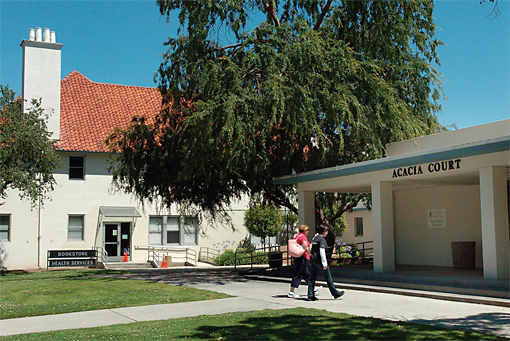| 제목 | [DAIKIN] HIGHER EDUCATION - CSU-SS | 작성일 | 16-06-16 13:49 |
| 글쓴이 | 최고관리자 | 조회수 | 4,332 |
본문
CASE STUDY
Higher Education
Name
California State University, Stanislaus-Stockton
Location
Stockton, CA USA
Facility Size
100-yard long concrete building built in the 1920s,
Issue
2 chiller units dating from the 1950s
Solution
Daikin Magnitude® magnetic bearing centrifugal chiller
Innovative Chiller Technology from Daikin Combined with Imaginative Renovation Creates a Showplace for Cal State Campus
The expansive, yet graceful Acacia Court Building in Stockton, California, originally a state hospital, has been given a new life. An extensive renovation has converted this 1920s, 100-yardlong concrete building into the campus showplace of California State University, Stanislaus-Stockton. Located in the 102-acre University Park, the building now houses faculty offices and classrooms for upper division and graduate courses.
Here, students can complete their degrees—without commuting to the main campus in Turlock—in the mixed-use Magnolia District, redesigned as a "live, work, walk" neighborhood. The renovation draws on unique technology, including an HVAC system designed around a Magnitude magnetic bearing centrifugal chiller from Daikin—with impressive results. The chiller consumes far less power, costs less to operate, and generates far less noise than conventional chillers.
In 2002, The Grupe Company, a respected California developer, was awarded the University Park contract to develop the area into classrooms, offices, shops, apartments and a community center. As many as 32 buildings were razed; 19 were renovated. Part of the goal was to keep floor plan changes to a minimum, primarily as a "renovate to suit" project.
As part of a thorough evaluation, The Grupe Company determined that the HVAC system was high on the list of systems to be updated at Acacia Court. The existing system included two chiller units dating from the 1950s, and some of the piping for them had collapsed. "The efficiency of the old system was really poor," said Chris Rasmussen, with The Grupe Company's facility management department. "We explained to the university that the building needed a new chiller, along with new piping and a cooling tower."
A new kind of chiller for an old building
The Daikin Magnitude chiller features magnetic bearing compressor technology that is oil free. This design significantly reduces sound levels, because the magnetic bearings eliminate the metal-to-metal contact noise of conventional bearings. Sound pressure ratings are as low as 77 dBA per ARI Standard 575. Energy performance is also revolutionary. The Daikin Magnitude centrifugal chiller operates as low as 0.375 kW/ton IPLV, the most efficient performance in its tonnage range in the industry. Full load performance is as low as 0.62 kW/ton—about 32 percent more efficient than screw compressor chillers. "The magnetic bearing technology of the Daikin Magnitude centrifugal chiller provides superior energy efficiency by eliminating the high friction losses of conventional centrifugal compressors," said Daryl Showalter, director of marketing Daikin chiller products.
"Variable frequency drives unload the chiller to 10 percent of full load. The chiller requires less than five amps to start, compared to 500 to 600 amps for a traditional screw compressor chiller. And, because magnetic bearings require no lubrication, there is no need for oil heaters, oil coolers, oil pumps or oil piping."
"A Really Good Experience"
Despite the completely new technology and design, installation went smoothly. "We had a really good experience," said Rasmussen. "We completed 90 percent of the installation work with our own maintenance staff, which really helped reduce the cost," Rasmussen added. "And since the system went online, there has been zero unscheduled downtime because of problems, only scheduled downtime for a couple of software upgrades."
The two compressors of the Magnitude chiller operate on a common refrigerant circuit, improving system reliability. In the event of a mechanical or electrical problem, one of the two compressors can continue to operate until repairs can be made. "If there is a problem with one compressor, we can still run with a 60 percent load on the other one," said Rasmussen.
The MicroTech II® digital unit controller on the chiller effectively runs and monitors the chiller operation. "We currently run the chiller based on a time clock input because there's not as many maintenance issues with the magnetic bearing compressors.
When the budget allows, we can integrate the MicroTech II chiller using BACnet®, LonTalk® or Modbus® protocol thanks to the Protocol Selectability® feature of the unit controller."
Saving on power, maintenance and cost
"As far as cost saving goes, it's just incredible," said Rasmussen. "The old chiller required 1,000 amps per leg at start-up. By contrast, when the new chiller starts up, each compressor takes only seven to 10 amps. Also, it ramps up more slowly, so we don't require a big surge of electricity in the beginning, which would be quite costly for the state."
Maintenance is equally worry-free. With the magnetic bearings compressors, the oil handling equipment of the chiller is eliminated. There is no need for oil pumps, oil reservoirs, oil coolers, etc. —and their associated maintenance costs—that are needed to maintain oil quality. The only requirement is to "punch tubes," or clean the pipes with a rotary brush, and blow out dust from the controls. "That's our PM (planned maintenance) for the chiller," said Rasmussen. "One other task we avoided is having to replace the refrigerant type in the near future." The Daikin Magnitude chiller already uses HFC-134a refrigerant, which has no phase-out date.
Subtracting Noise
Noise is the other big plus with the Magnitude chiller—or rather, minus, since noise is almost completely missing. "We have an air compressor in the basement, and when the air compressor is running, we can't tell if the chiller is also running," said Rasmussen. "We actually have to walk up to the unit to see if it's still going. We also have a couple of screw chillers at the university, and you can hear them all the way up from the basement to the first floor. They're totally different from the Daikin chiller."
For the university, the quiet new chiller makes the old building more usable as well as more efficient. While only a portion of the building is currently occupied, development plans include moving other university departments, as well as a computer lab, to Acacia Court.
Students and staff who use the building now and in the future will benefit not only from the renovated building and its technologically-advanced chiller, but also the entire "livable" concept of the Magnolia District.

The two compressors of the Magnitude chiller operate on a common refrigerant circuit, improving system reliability.
| 이전글 | [DAIKIN] HIGHER EDUCATION - Bethel University 2016-06-16 | ||
| 다음글 | [DAIKIN] HIGHER EDUCATION - Education City Qatar 2016-06-16 | ||






